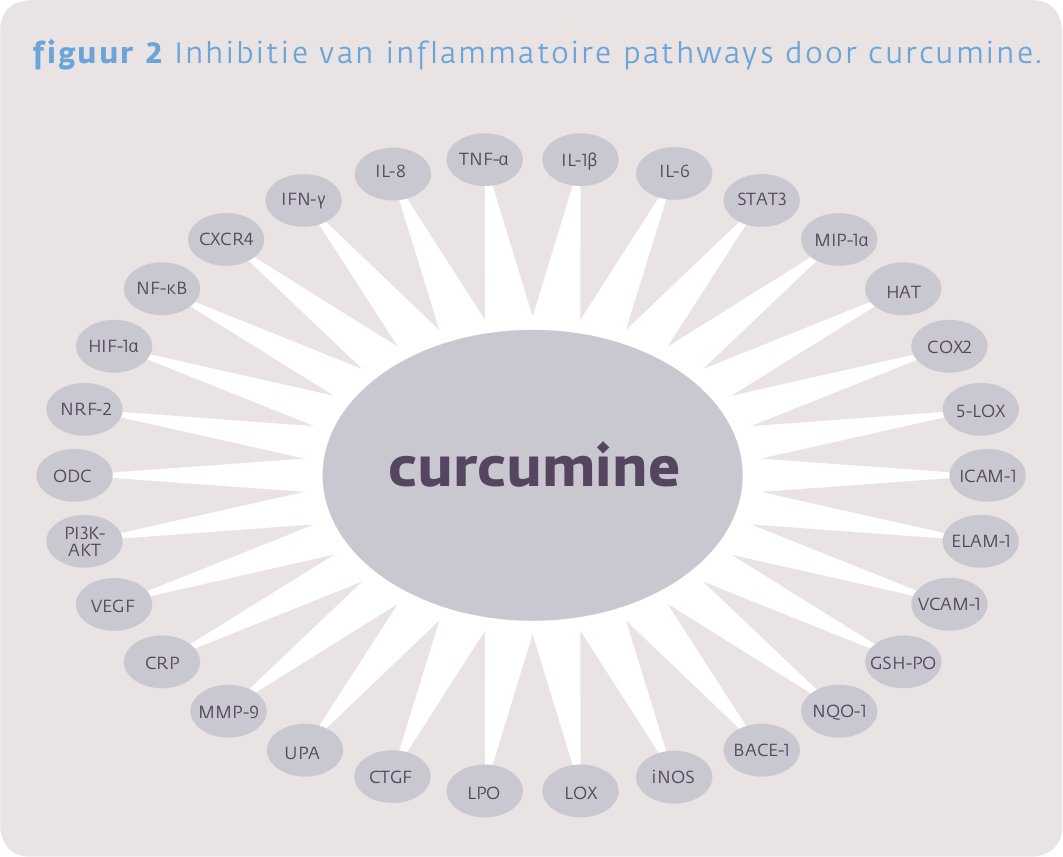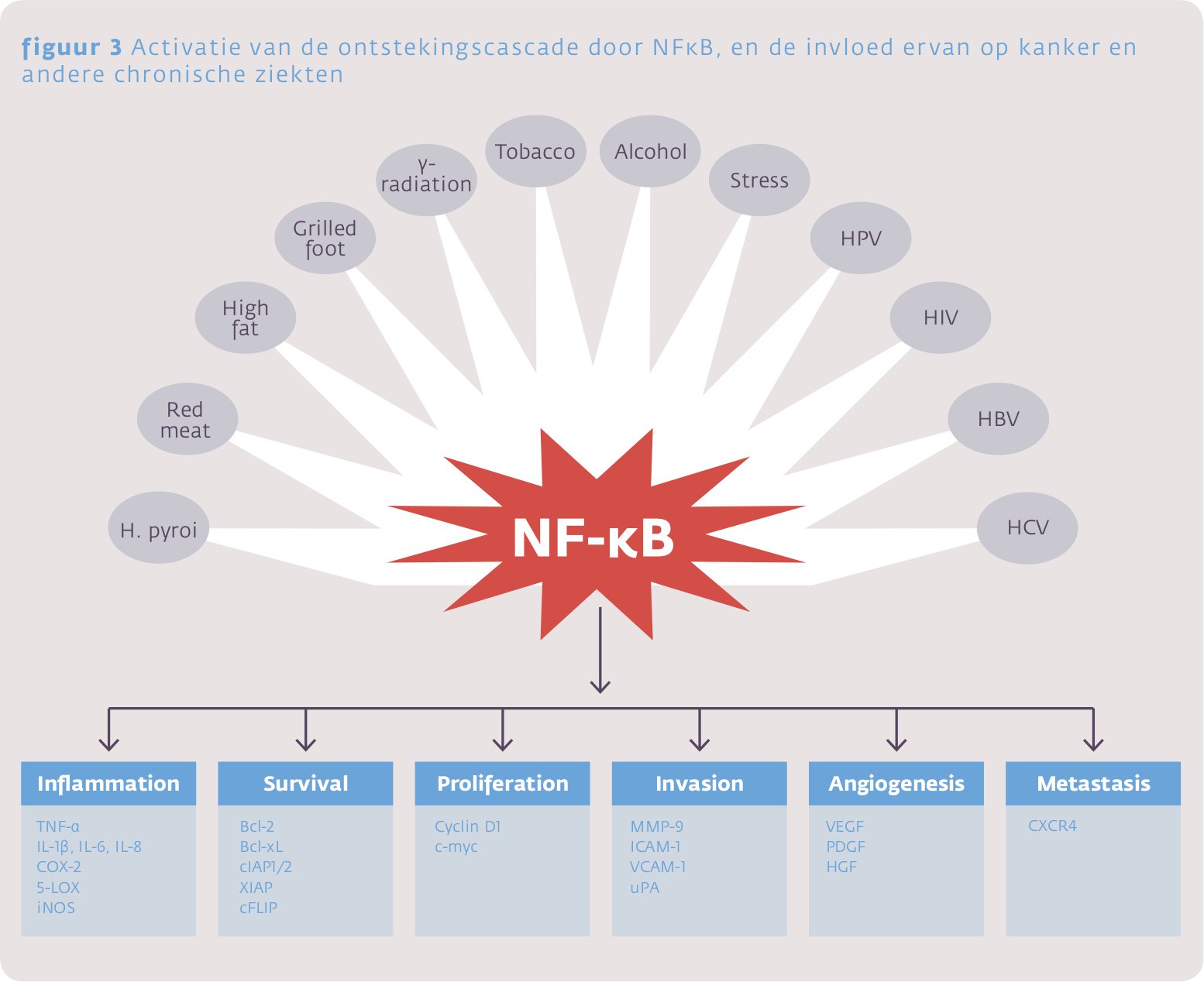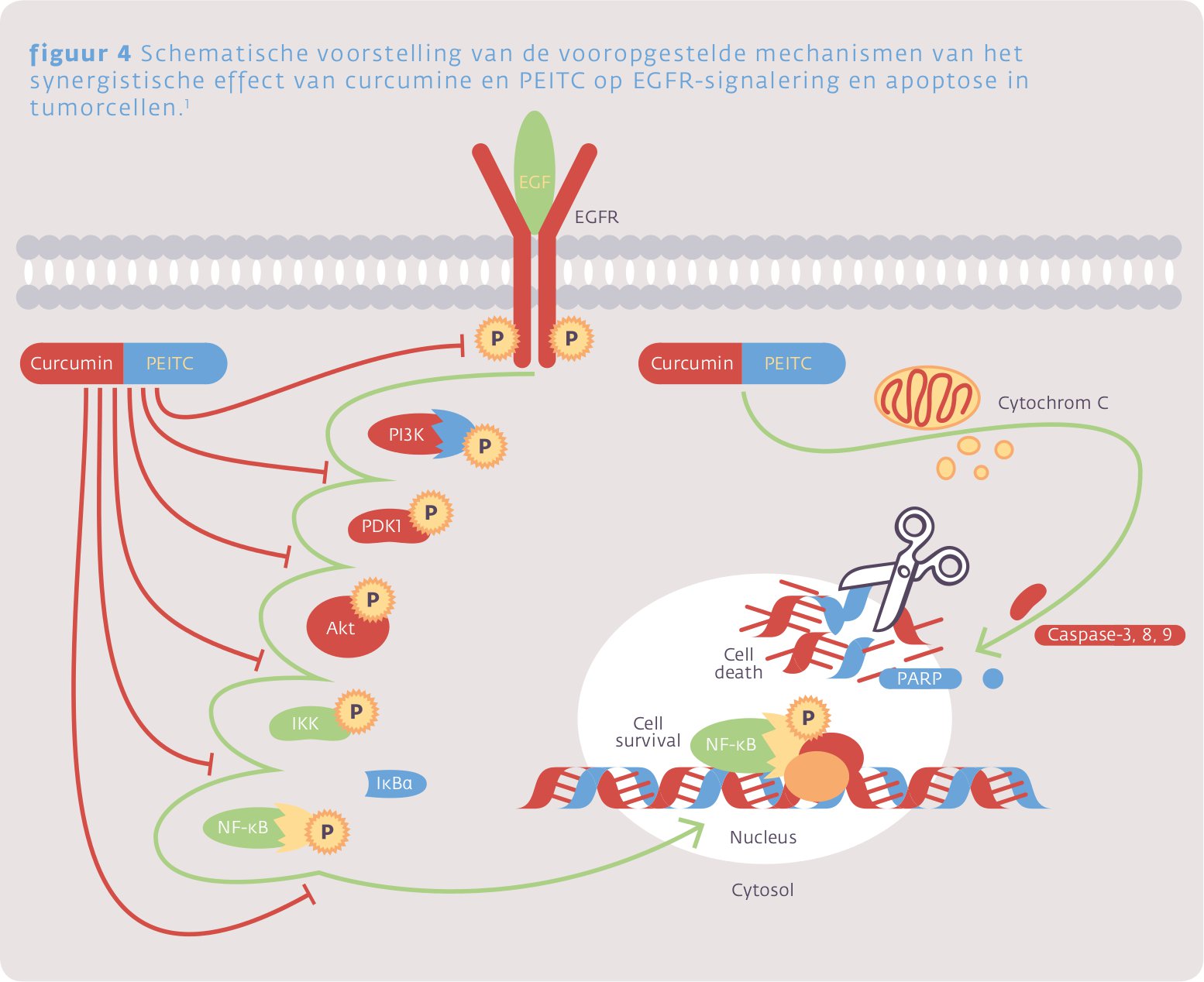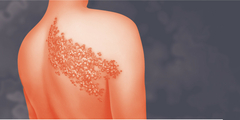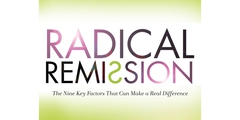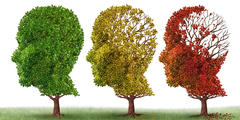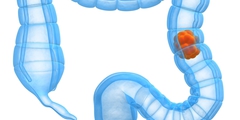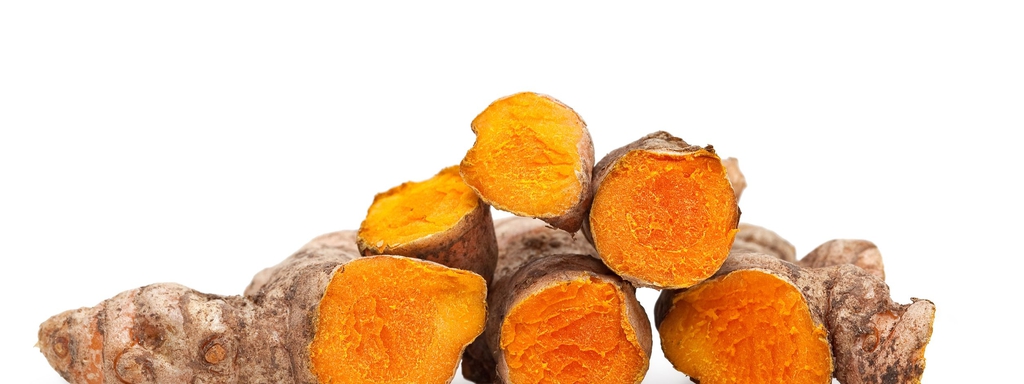
Curcumine, het hoofdbestanddeel uit kurkuma, de specerij gemaakt uit het rhizoom (wortelstok) van de Curcuma longa (Turmeric, Aziatische geelwortel) is in India ook bekend als het ‘heilige poeder’ of ‘Indisch goud’.
Wondermiddeltjes, die ‘voor alles goed zijn’, worden meestal naar het rijk der fabeltjes verwezen. Maar curcumine is één van de weinige stoffen die het predikaat ‘panacea’ met ere mag dragen en de beloften ook blijkt te kunnen waarmaken. Tot voor kort ondersteunde vooral epidemiologisch, labo- en dieronderzoek de oeroude gezondheidsclaims uit de Aziatische geneeskunde. Maar de laatste jaren neemt ook het humaan onderzoek, mét klinische studies, spectaculair toe. De interesse naar curcumine is enorm, en de farmaceutische industrie sponsort ijverig onderzoek met curcumine-analogen ...
Beste bezoeker, u heeft geen toegang.
Enkel (web)abonnees hebben toegang tot tijdschriftartikelen. Het webabonnement is nog in de maak.
U kunt zich wel alvast (gratis) registreren en tal van andere webartikelen raadplegen!
Auteur
Trefwoorden:
Verschenen in
Referenties
1. de Munck-Khoe K. Curcumine bij kanker. A&A 2007/3:32-37.
2. Nys M. Het Ontstekingssyndroom. A&A 2006/4:14-21
3. Nys M. Bescherm je gezondheid met kruisbloemige groenten, 1. A&A 2008/3: 44-49
4. Nys M. Bescherm je gezondheid met kruisbloemige groenten, 2. A&A 2008/4:
5. Nys M. Waterkers. A&A 2006/5:38-42
6. Timmer S. Curcuma verassend veelzijdig. VanNature 2005/5: 54-8.
7. Wuyts D. Propriétés diététiques et médicinales de nos aliments et épices. 2011 Uitg SATAS: ISBN 978-2-87293-121-7
8. De Maerteleire E. Bioactieve stoffen in de voeding. 2005 Elsevier: ISBN 90 352 2798 0
9. Gupta SC, Patchva S, Koh W, Aggarwal BB. Discovery of Curcumin, a Component of the Golden Spice, and Its Miraculous Biological Activities. Clin Exp Pharmacol Physiol. 2011 Nov 24. [Epub ahead of print]
10. Monograph Rhizoma Curcumae Longae. In: WHO monographs on selected medicinal plants, vol 1 Genf 1999;115-124
11. Curcuma longa (turmeric). Monograph. Altern Med Rev. 2001;6S:S62-6.
12. Sharma RA, Gescher AJ, Steward WP. Curcumin: the story so far. Eur J Cancer 2005;41(13):1955-1968
13. Maheshwari RK, Singh AK, Gaddipati J et al. Multiple biological activities of curcumin: a short review. Life Sci. 2006;78(18):2081-7
14. Aggarwal BB et al. Identification of novel anti-inflammatory agents from Ayurvedic medicine for prevention of chronic diseases: ""reverse pharmacology"" and ""bedside to bench"" approach. Curr Drug Targets. 2011 Oct;12(11):1595-653.
15. Ravindran J, PrasadS, Bharat B. Curcumin and Cancer Cells: How Many Ways Can Curry Kill Tumor Cells Selectively? AAPS J. 2009 September; 11(3): 495–510.
16. Anand P, Sundaram C, Jhurani S, Kunnumakkara AB, Aggarwal BB. Curcumin and cancer: an ""old-age"" disease with an ""age-old"" solution. Cancer Lett. 2008;267:133–64.
17. Zhou H, Beevers CS, Huang S. The targets of curcumin. Curr Drug Targets. 2011 Mar 1;12(3):332-47.
18. Gupta SC, Prasad S, Kim JH, Patchva S, Webb LJ, Priyadarsini IK, Aggarwal BB. Multitargeting by curcumin as revealed by molecular interaction studies.Nat Prod Rep. 2011 Nov 15;28(12):1937-55.
19. Shehzad A, Wahid F, Lee YS. Curcumin in cancer chemoprevention: molecular targets, pharmacokinetics, bioavailability, and clinical trials. Arch Pharm (Weinheim). 2010 Sep;343(9):489-99.
20. Aggarwal BB, Harikumar KB. Potential therapeutic effects of curcumin, the anti-inflammatory agent, against neurodegenerative, cardiovascular, pulmonary, metabolic, autoimmune and neoplastic diseases. Int J Biochem Cell Biol. 2009 Jan;41(1):40-59.
21. Martin RC, Aiyer HS, Malik D, Li Y. Effect on pro-inflammatory and antioxidant genes and bioavailable distribution of whole turmeric vs curcumin: Similar root but different effects. Food Chem Toxicol. 2011 Nov 4. [Epub ahead of print]
22. Gupta SC, Prasad S, Kim JH, Patchva S, Webb LJ, Priyadarsini IK, Aggarwal BB. Multitargeting by curcumin as revealed by molecular interaction studies. Nat Prod Rep. 2011 Nov 15;28(12):1937-55.
23. Kumar A, Ahuja A, Ali J, Baboota S. Conundrum and therapeutic potential of curcumin in drug delivery. Crit Rev Ther Drug Carrier Syst. 2010;27(4):279-312.
24. Bisht S, Maitra A. Systemic delivery of curcumin: 21st century solutions for an ancient conundrum. Curr Drug Discov Technol. 2009 Sep;6(3):192-9.
25. Sharma RA, Steward WP, Gescher AJ. Pharmacokinetics and pharmacodynamics of curcumin. Adv Exp Med Biol. 2007;595:453-70.
26. Tu SP, Jin H, Shi JD, Zhu LM, Suo Y, Lu G, Liu A, Wang TC, Yang CS. Curcumin Induces the Differentiation of Myeloid-Derived Suppressor Cells and Inhibits Their Interaction with Cancer Cells and Related Tumor Growth. Cancer Prev Res (Phila). 2011 Nov 23. [Epub ahead of print]
27. Shahani K et al. Injectable Sustained Release Microparticles of Curcumin: A New Concept for Cancer Chemoprevention. Cancer Prev Res August 2011 4; 1158.
28. Bansal SS et al. Advanced Drug Delivery Systems of Curcumin for Cancer Chemoprevention Cancer Prev Res 2011;4(8); 1158–71.
29. Zhu HL, Ji JL, Huang XF. Curcumin and its Formulations: Potential Anti-Cancer Agents. Anticancer Agents Med Chem. 2011 Oct 25. [Epub ahead of print]
30. Malek SN, Lee GS, Hong SL, Yaacob H, Wahab NA, Faizal Weber JF, Shah SA. Phytochemical and cytotoxic investigations of Curcuma mangga rhizomes. Molecules. 2011 May 31;16(6):4539-48.
31. Curcumin―The Paradigm of a Multi-Target Natural Compound with Applications in Cancer Prevention and Treatment
32. Epstein J, Sanderson IR, Macdonald TT. Curcumin as a therapeutic agent: the evidence from in vitro, animal and human studies. Br J Nutr. 2010 Jun;103(11):1545-57.
33. Teiten MH, Eifes S, Dicato M, Diederich M. Curcumin―The Paradigm of a Multi-Target Natural Compound with Applications in Cancer Prevention and Treatment. Toxins (Basel). 2010 January; 2(1): 128–162.
34. Basnet P, Skalko-Basnet N. Curcumin: an anti-inflammatory molecule from a curry spice on the path to cancer treatment. Molecules. 2011 Jun 3;16(6):4567-98.
35. Jurenka JS. Anti-inflammatory properties of curcumin, a major constituent of Curcuma longa: a review of preclinical and clinical research. Altern Med Rev. 2009 Jun;14(2):141-53.
36. Aggarwal BB, Sung B. Pharmacological basis for the role of curcumin in chronic diseases: an age-old spice with modern targets. Trends Pharmacol Sci. 2009 Feb;30(2):85-94.
37. Aggarwal BB, Harikumar KB. Potential therapeutic effects of curcumin, the anti-inflammatory agent, against neurodegenerative, cardiovascular, pulmonary, metabolic, autoimmune and neoplastic diseases. Int J Biochem Cell Biol.
38. Aggarwal BB et al. Identification of novel anti-inflammatory agents from Ayurvedic medicine for prevention of chronic diseases: ""reverse pharmacology"" and ""bedside to bench"" approach. Curr Drug Targets. 2011 Oct;12(11):1595-653.
39. Gupta SC, Kim JH, Kannappan R, Reuter S, Dougherty PM, Aggarwal BB. Role of nuclear factor κB-mediated inflammatory pathways in cancer-related symptoms and their regulation by nutritional agents. Exp Biol Med (Maywood). 2011 Jun 1;236(6):658-71.
40. Gogada R, Amadori M, Zhang H, Jones A, Verone A, Pitarresi J, Jandhyam S, Prabhu V, Black JD, Chandra D. Curcumin induces Apaf-1 dependent, p21-mediated caspase activation and apoptosis. Cell Cycle. 2011 Dec 1;10(23). [Epub ahead of print]
41. Schaffer M, Schaffer PM, Zidan J, Bar Sela G. Curcuma as a functional food in the control of cancer and inflammation. Curr Opin Clin Nutr Metab Care. 2011 Nov;14(6):588-97.
42. Ravindran J, PrasadS, Bharat B. Curcumin and Cancer Cells: How Many Ways Can Curry Kill Tumor Cells Selectively? AAPS J. 2009 September; 11(3): 495–510.
43. Das T, Sa G, Saha B, Das K. Multifocal signal modulation therapy of cancer: ancient weapon, modern targets. Mol Cell Biochem. 2010 Mar;336(1-2):85-95.
44. Bachmeier BE, Killian P, Pfeffer U, Nerlich AG. Novel aspects for the application of Curcumin in chemoprevention of various cancers. Front Biosci (Schol Ed). 2010 Jan 1;2:697-717.
45. Shehzad A, Wahid F, Lee YS. Curcumin in cancer chemoprevention: molecular targets, pharmacokinetics, bioavailability, and clinical trials. Arch Pharm (Weinheim). 2010 Sep;343(9):489-99.
46. Russo M, Spagnuolo C, Tedesco I, Russo GL. Phytochemicals in Cancer Prevention and Therapy: Truth or Dare? Toxins 2010;2:517-551.
47. Shu L, Khor TO, Lee JH, Boyanapalli SS, Huang Y, Wu TY, Saw CL, Cheung KL, Kong AN. Epigenetic CpG Demethylation of the Promoter and Reactivation of the Expression of Neurog1 by Curcumin in Prostate LNCaP Cells. AAPS J. 2011 Dec;13(4):606-14.
48. Meeran SM, Ahmed A, Tollefsbol TO. Epigenetic targets of bioactive dietary components for cancer prevention and therapy. Clin Epigenetics. 2010 Dec 1;1(3-4):101-116.
49. Reuter S, Gupta SC, Park B, Goel A, Aggarwal BB. Epigenetic changes induced by curcumin and other natural compounds. Genes Nutr. 2011 May;6(2):93-108.
50. Lai HW, Chien SY, Kuo SJ, Tseng LM, Lin HY, Chi CW, Chen DR. The Potential Utility of Curcumin in the Treatment of HER-2-Overexpressed Breast Cancer: An In Vitro and In Vivo Comparison Study with Herceptin. Evid Based Complement Alternat Med. 012;2012:486568. Epub 2011 Jun 6.
51. Liu S, Wang Z, Hu Z, Zeng X, Li Y, Su Y, Zhang C, Ye Z. Anti-tumor activity of curcumin against androgen-independent prostate cancer cells via inhibition of NF-κB and AP-1 pathway in vitro. J Huazhong Univ Sci Technolog Med Sci. 2011 Aug;31(4):530-4.
52. Pollard HB, Srivastava M, Srivatsan ES, Wang MB. Curcumin treatment suppresses IKKβ kinase activity of salivary cells of patients with head and neck cancer: a pilot study. Clin Cancer Res. 2011 Sep 15;17(18):5953-61.
53. Wilken R, Srivatsan Es et al. Curcumin: A review of anti-cancer properties and therapeutic activity in head and neck squamous cell carcinoma. Molecular Cancer 2011, 10:12
54. Villegas I, Sanchez-Fidalgo S, Alarcon de la Lastra C. New mechanisms and therapeutic potential of curcumin for colorectal cancer. Mol Nutr Food Res. 2008;52(9):1040–1061.
55. Shishodia S, Chaturvedi MM, Aggarwal BB. Role of curcumin in cancer therapy. Curr Probl Cancer. 2007;31(4):243–305.
56. Lopez-Lazaro M. Anticancer and carcinogenic properties of curcumin: considerations for its clinical development as a cancer chemopreventive and chemotherapeutic agent. Mol Nutr Food Res. 2008;52(Suppl 1):S103–127.
57. Aggarwal BB, Banerjee S, Bharadwaj U, Sung B, Shishodia S, Sethi G. Curcumin induces the degradation of cyclin E expression through ubiquitin-dependent pathway and up-regulates cyclin-dependent kinase inhibitors p21 and p27 in multiple human tumor cell lines. Biochem Pharmacol. 2007;73(7):1024–1032.
58. Carroll RE, Benya RV, Turgeon DK, Vareed S, Neuman M, Rodriguez L, Kakarala M, Carpenter PM, McLaren C, Meyskens FL Jr, Brenner DE. Phase IIa clinical trial of curcumin for the prevention of colorectal neoplasia. Cancer Prev Res (Phila). 2011 Mar;4(3):354-64.
59. Marathe SA, Dasgupta I, Gnanadhas DP, Chakravortty D. Multifaceted roles of curcumin: two sides of a coin! Expert Opin Biol Ther. 2011 Nov;11(11):1485-99.
60. Lu JJ, Cai YJ, Ding J. Curcumin induces DNA damage and caffeine-insensitive cell cycle arrest in colorectal carcinoma HCT116 cells. Mol Cell Biochem. 2011 Aug;354(1-2):247-52.
61. Chen A, Xu J, Johnson AC. Curcumin inhibits human colon cancer cell growth by suppressing gene expression of epidermal growth factor receptor through reducing the activity of the transcription factor Egr-1. Oncogene. 2006;25(2):278–287.
62. Lee YJ, Kim NY, Suh YA, Lee C. Involvement of ROS in Curcumin-induced Autophagic Cell Death. Korean J Physiol Pharmacol. 2011 Feb;15(1):1-7.
63. He ZY, Shi CB, Wen H, Li FL, Wang BL, Wang J. Upregulation of p53 expression in patients with colorectal cancer by administration of curcumin. Cancer Invest. 2011 Mar;29(3):208-13.
64. Watson JL, Greenshields A, Hill R, Hilchie A, Lee PW, Giacomantonio CA, Hoskin DW. Curcumin-induced apoptosis in ovarian carcinoma cells is p53-independent and involves p38 mitogen-activated protein kinase activation and downregulation of Bcl-2 and survivin expression and Akt signaling. Mol Carcinog. 2010 Jan;49(1):13-24.
65. Wong TF, Takeda T, Li B, Tsuiji K, Kitamura M, Kondo A, Yaegashi N. Curcumin disrupts uterine leiomyosarcoma cells through AKT-mTOR pathway inhibition. Gynecol Oncol. 2011 Jul;122(1):141-8.
66. Zong H, Wang F, Fan QX, Wang LX. Curcumin inhibits metastatic progression of breast cancer cell through suppression of urokinase-type plasminogen activator by NF-kappa B signaling pathways.Mol Biol Rep. 2011 Sep 24. [Epub ahead of print]
67. Liu HS, Ke CS, Cheng HC, Huang CY, Su CL. Curcumin-induced mitotic spindle defect and cell cycle arrest in human bladder cancer cells occurs partly through inhibition of Aurora A. Mol Pharmacol. 2011 Oct;80(4):638-46.
68. Wang Y, Rishi AK, Wu W, Polin L, Sharma S, Levi E, Albelda S, Pass HI, Wali A. Curcumin suppresses growth of mesothelioma cells in vitro and in vivo, in part, by stimulating apoptosis. Mol Cell Biochem. 2011 Nov;357(1-2):83-94.
69. Kuo CL, Wu SY, Ip SW, Wu PP, Yu CS, Yang JS, Chen PY, Wu SH, Chung JG. Apoptotic death in curcumin-treated NPC-TW 076 human nasopharyngeal carcinoma cells is mediated through the ROS, mitochondrial depolarization and caspase-3-dependent signaling responses. Int J Oncol. 2011 Aug;39(2):319-28.
70. Liao S, Xia J, Chen Z, Zhang S, Ahmad A, Miele L, Sarkar FH, Wang Z. Inhibitory effect of curcumin on oral carcinoma CAL-27 cells via suppression of Notch-1 and NF-κB signaling pathways. J Cell Biochem. 2011 Apr;112(4):1055-65.
71. Chen JW, Tang YL, Liu H, Zhu ZY, Lü D, Geng N, Chen Y. Anti-proliferative and anti-metastatic effects of curcumin on oral cancer cells. Hua Xi Kou Qiang Yi Xue Za Zhi. 2011 Feb;29(1):83-6.
72. Chen QY, Shi JG, Yao QH, Jiao DM, Wang YY, Hu HZ, Wu YQ, Song J, Yan J, Wu LJ. Lysosomal membrane permeabilization is involved in curcumin-induced apoptosis of A549 lung carcinoma cells. Mol Cell Biochem. 2012 Jan;359(1-2):389-98.
73. Tung YT, Chen HL, Lai CW, Shen CJ, Lai YW, Chen CM. Curcumin reduces pulmonary tumorigenesis in vascular endothelial growth factor (VEGF)-overexpressing transgenic mice. Mol Nutr Food Res. 2011 Jul;55(7):1036-43.
74. Liu YL, Yang HP, Gong L, Tang CL, Wang HJ. Hypomethylation effects of curcumin, demethoxycurcumin and bisdemethoxycurcumin on WIF-1 promoter in non-small cell lung cancer cell lines. Mol Med Report. 2011 Jul-Aug;4(4):675-9.
75. Yang CL, Ma YG, Xue YX, Liu YY, Xie H, Qiu GR. Curcumin Induces Small Cell Lung Cancer NCI-H446 Cell Apoptosis via the Reactive Oxygen Species-Mediated Mitochondrial Pathway and Not the Cell Death Receptor Pathway. DNA Cell Biol. 2011 Jun 28. [Epub ahead of print]
76. Khan SI, Aumsuwan P, Khan IA, Walker LA, Dasmahapatra AK. Epigenetic Events Associated with Breast Cancer and Their Prevention by Dietary Components Targeting the Epigenome. Chem Res Toxicol. 2011 Oct 28. [Epub ahead of print]
77. Langone P, Debata PR, Dolai S, Curcio GM, Inigo JD, Raja K, Banerjee P. Coupling to a cancer cell-specific antibody potentiates tumoricidal properties of curcumin. Int J Cancer. 2011 Oct 11. doi: 10.1002/ijc.26479. [Epub ahead of print]
78. Prakobwong S, Gupta SC, Kim JH, Sung B, Pinlaor P, Hiraku Y, Wongkham S, Sripa B, Pinlaor S, Aggarwal BB. Curcumin suppresses proliferation and induces apoptosis in human biliary cancer cells through modulation of multiple cell signaling pathways. Carcinogenesis. 2011 Sep;32(9):1372-80.
79. Darvesh AS, Aggarwal BB, Bishayee A. Curcumin and Liver Cancer: A Review. Curr Pharm Biotechnol. 2011 Apr 5.
80. Aggarwal S, Ndinguri MW, Solipuram R, Wakamatsu N, Hammer RP, Ingram D, Hansel W. [DLys(6)]-luteinizing hormone releasing hormone-curcumin conjugate inhibits pancreatic cancer cell growth in vitro and in vivo. Int J Cancer. 2011 Oct 1;129(7):1611-23.
81. Cancer Chemother Pharmacol. 2011 Jul;68(1):157-64. Epub 2010 Sep 22.
82. Kanai M, Aggarwal BB et al. A phase I/II study of gemcitabine-based chemotherapy plus curcumin for patients with gemcitabine-resistant pancreatic cancer. Cancer Chemother Pharmacol. 2011 Jul;68(1):157-64.
83. Ng AP, Chng WJ, Khan M. Curcumin sensitizes acute promyelocytic leukemia cells to unfolded protein response-induced apoptosis by blocking the loss of misfolded N-CoR protein. Mol Cancer Res. 2011 Jul;9(7):878-88.
84. Das L, Vinayak M. Anti-carcinogenic action of curcumin by activation of antioxidant defence system and inhibition of NF-κB signalling in lymphoma-bearing mice. Biosci Rep. 2012 Apr 1;32(2):161-70.
85. Abusnina A, Keravis T, Yougbaré I, Bronner C, Lugnier C. Anti-proliferative effect of curcumin on melanoma cells is mediated by PDE1A inhibition that regulates the epigenetic integrator UHRF1. Mol Nutr Food Res. 2011 Nov;55(11):1677-89.
86. Curcumin exerts its anti-cancer property by targeting PDE1 that inhibits melanoma cell proliferation
87. Lee SJ, Krauthauser C, Maduskuie V, Fawcett PT, Olson JM, Rajasekaran SA.
88. Curcumin-induced HDAC inhibition and attenuation of medulloblastoma growth in vitro and in vivo. BMC Cancer. 2011 Apr 18;11:144.
89. Karunagaran D, Rashmi R, Kumar TR. Induction of apoptosis by curcumin and its implications for cancer therapy. Curr Cancer Drug Targets. 2005 Mar;5(2):117-29.
90. Dikmen M, Canturk Z, Ozturk Y, Tunali Y. Investigation of the apoptotic effect of curcumin in human leukemia HL-60 cells by using flow cytometry. Cancer Biother Radiopharm. 2010 Dec;25(6):749-55.
91. Ströfer M, Jelkmann W, Depping R. Curcumin decreases survival of Hep3B liver and MCF-7 breast cancer cells: the role of HIF. Strahlenther Onkol. 2011 Jul;187(7):393-400.
92. Kunnumakkara AB, Anand P, Aggarwal BB. Curcumin inhibits proliferation, invasion, angiogenesis and metastasis of different cancers through interaction with multiple cell signaling proteins. Cancer Lett. 2008 Oct 8;269(2):199-225
93. Goel A, Aggarwal BB. Curcumin, the golden spice from Indian saffron, is a chemosensitizer and radiosensitizer for tumors and chemoprotector and radioprotector for normal organs. Nutr Cancer. 2010;62(7):919-30.
94. Calaf GM, Echiburú-Chau C, Wen G, Balajee AS, Roy D. Effect of curcumin on irradiated and estrogen-transformed human breast cell lines. Int J Oncol. 2011 Oct 12. doi: 10.3892/ijo.2011.1228. [Epub ahead of print]
95. Lai HW, Chien SY, Kuo SJ, Tseng LM, Lin HY, Chi CW, Chen DR.The Potential Utility of Curcumin in the Treatment of HER-2-Overexpressed Breast Cancer: An In Vitro and In Vivo Comparison Study with Herceptin. Evid Based Complement Alternat Med. 2012;2012:486568.
96. Ko JC, Tsai MS, Weng SH, Kuo YH, Chiu YF, Lin YW. Curcumin enhances the mitomycin C-induced cytotoxicity via downregulation of MKK1/2-ERK1/2-mediated Rad51 expression in non-small cell lung cancer cells. Toxicol Appl Pharmacol. 2011 Sep 15;255(3):327-38.
97. Fossey SL, Bear MD, Lin J, Li C, Schwartz EB, Li PK, Fuchs JR, Fenger J, Kisseberth WC, London CA. The novel curcumin analog FLLL32 decreases STAT3 DNA binding activity and expression, and induces apoptosis in osteosarcoma cell lines. BMC Cancer. 2011 Mar 28;11:112.
98. Bill MA, Fuchs JR, Li C, Yui J, Bakan C, Benson DM Jr, Schwartz EB, Abdelhamid D, Lin J, Hoyt DG, Fossey SL, Young GS, Carson WE 3rd, Li PK, Lesinski GB. The small molecule curcumin analog FLLL32 induces apoptosis in melanoma cells via STAT3 inhibition and retains the cellular response to cytokines with anti-tumor activity. Mol Cancer. 2010 Jun 25;9:165.
99. Mujtaba T, Kanwar J, Wan SB, Chan TH, Dou QP. Sensitizing human multiple myeloma cells to the proteasome inhibitor bortezomib by novel curcumin analogs. Int J Mol Med. 2012 Jan;29(1):102-6.
100. Yu LL, Wu JG, Dai N, Yu HG, Si JM. Curcumin reverses chemoresistance of human gastric cancer cells by downregulating the NF-κB transcription factor. Oncol Rep. 2011 Nov;26(5):1197-203. doi: 10.3892/or.2011.1410. Epub 2011 Aug 2.
101. Abuzeid WM, Davis S, Tang AL, Saunders L, Brenner JC, Lin J, Fuchs JR, Light E, Bradford CR, Prince ME, Carey TE. Sensitization of head and neck cancer to cisplatin through the use of a novel curcumin analog. Arch Otolaryngol Head Neck Surg. 2011 May;137(5):499-507.
102. monotherapy induces a potent antitumor effect and sensitizes cancer cells to cisplatin, permitting an equivalent or improved antitumor effect at lower doses of cisplatin.
103. Bao B, Ali S, Banerjee S, Wang Z, Logna F, Azmi AS, Kong D, Ahmad A, Li Y, Padhye S, Sarkar FH. Curcumin analog CDF inhibits pancreatic tumor growth by switching on suppressor microRNAs and attenuating EZH2 expression. Cancer Res. 2011 Nov 22. [Epub ahead of print]
104. Nambiar D, Rajamani P, Singh RP. Effects of phytochemicals on ionization radiation-mediated carcinogenesis and cancer therapy. Mutat Res. 2011 Nov-Dec;728(3):139-57.
105. Anand P, Sung B, Kunnumakkara AB, Rajasekharan KN, Aggarwal BB. Suppression of pro-inflammatory and proliferative pathways by diferuloylmethane (curcumin) and its analogues dibenzoylmethane, dibenzoylpropane, and dibenzylideneacetone: Role of Michael acceptors and Michael donors. Biochem Pharmacol. 2011 Dec 15;82(12):1901-9.
106. Sen GS, Mohanty S, Hossain DM, Bhattacharyya S, Banerjee S, Chakraborty J, Saha S, Ray P, Bhattacharjee P, Mandal D, Bhattacharya A, Chattopadhyay S, Das T, Sa G. Curcumin Enhances the Efficacy of Chemotherapy by Tailoring p65NFκB-p300 Cross-talk in Favor of p53-p300 in Breast Cancer. J Biol Chem. 2011 Dec 9;286(49):42232-47.
107. Zhou QM, Wang XF, Liu XJ, Zhang H, Lu YY, Su SB. Curcumin enhanced antiproliferative effect of mitomycin C in human breast cancer MCF-7 cells in vitro and in vivo. Acta Pharmacol Sin. 2011 Nov;32(11):1402-10.
108. Lee JY, Lee YM, Chang GC, Yu SL, Hsieh WY, Chen JJ, Chen HW, Yang PC. Curcumin induces EGFR degradation in lung adenocarcinoma and modulates p38 activation in intestine: the versatile adjuvant for gefitinib therapy. PLoS One. 2011;6(8):e23756.
109. Rao J, Xu DR, Zheng FM, Long ZJ, Huang SS, Wu X, Zhou WH, Huang RW, Liu Q. Curcumin reduces expression of Bcl-2, leading to apoptosis in daunorubicin-insensitive CD34+ acute myeloid leukemia cell lines and primary sorted CD34+ acute myeloid leukemia cells. J Transl Med. 2011 May 19;9:71.
110. Sukumari-Ramesh S, Bentley JN, Laird MD, Singh N, Vender JR, Dhandapani KM. Dietary phytochemicals induce p53- and caspase-independent cell death in human neuroblastoma cells. Int J Dev Neurosci. 2011 Nov;29(7):701-10
111. Weng SH, Tsai MS, Chiu YF, Kuo YH, Chen HJ, Lin YW. Enhancement of Mitomycin C-Induced Cytotoxicity by Curcumin Results from Down-Regulation of MKK1/2-ERK1/2-Mediated Thymidine Phosphorylase Expression. Basic Clin Pharmacol Toxicol. 2011 Oct 4. [Epub ahead of print]
112. Patel BB, Majumdar AP. Synergistic role of curcumin with current therapeutics in colorectal cancer: minireview. Nutr Cancer. 2009;61(6):842–846.
113. Dorai T, Dutcher JP, Dempster DW, Wiernik PH. Therapeutic potential of curcumin in prostate cancer--V: Interference with the osteomimetic properties of hormone refractory C4-2B prostate cancer cells. Prostate. 2004;60(1):1–17.
114. Calaf GM, Echiburú-Chau C, Roy D, Chai Y, Wen G, Balajee AS. Protective role of curcumin in oxidative stress of breast cells. Oncol Rep. 2011 Oct;26(4):1029-35.
115. Nautiyal J, Kanwar SS, Yu Y, Majumdar AP. Combination of dasatinib and curcumin eliminates chemo-resistant colon cancer cells. J Mol Signal. 2011 Jul 20;6:7.
116. Calaf GM, Echiburú-Chau C, Wen G, Balajee AS, Roy D. Effect of curcumin on irradiated and estrogen-transformed human breast cell lines. Int J Oncol. 2012 Feb;40(2):436-42
117. Ströfer M, Jelkmann W, Depping R. Curcumin decreases survival of Hep3B liver and MCF-7 breast cancer cells: the role of HIF. Strahlenther Onkol. 2011 Jul;187(7):393-400.
118. Sukumari-Ramesh S, Bentley JN, Laird MD, Singh N, Vender JR, Dhandapani KM. Dietary phytochemicals induce p53- and caspase-independent cell death in human neuroblastoma cells. Int J Dev Neurosci. 2011 Nov;29(7):701-10
119. Veeraraghavan J, Natarajan M, Lagisetty P, Awasthi V, Herman TS, Aravindan N. Impact of curcumin, raspberry extract, and neem leaf extract on rel protein-regulated cell death/radiosensitization in pancreatic cancer cells. Pancreas. 2011 Oct;40(7):1107-19.
120. Lin L, Liu Y, Li H, Li PK, Fuchs J, Shibata H, Iwabuchi Y, Lin J. Targeting colon cancer stem cells using a new curcumin analogue, GO-Y030. Br J Cancer. 2011 Jul 12;105(2):212-20.
121. Zhou QM, Wang XF, Liu XJ, Zhang H, Lu YY, Huang S, Su SB. Curcumin improves MMC-based chemotherapy by simultaneously sensitising cancer cells to MMC and reducing MMC-associated side-effects. Eur J Cancer. 2011 Sep;47(14):2240-7.
122. Zhou QM, Wang XF, Liu XJ, Zhang H, Lu YY, Su SB. Curcumin enhanced antiproliferative effect of mitomycin C in human breast cancer MCF-7 cells in vitro and in vivo. Acta Pharmacol Sin. 2011 Nov;32(11):1402-10.
123. Lin HP, Kuo LK, Chuu CP. Combined Treatment of Curcumin and Small Molecule Inhibitors Suppresses Proliferation of A549 and H1299 Human Non-Small-Cell Lung Cancer Cells. Phytother Res. 2011 May 12. doi: 10.1002/ptr.3523. [Epub ahead of print]
124. Qian H, Yang Y, Wang X. Curcumin enhanced adriamycin-induced human liver-derived Hepatoma G2 cell death through activation of mitochondria-mediated apoptosis and autophagy. Eur J Pharm Sci. 2011 Jun 14;43(3):125-31.
125. Qian H, Yang Y, Wang X. Curcumin enhanced adriamycin-induced human liver-derived Hepatoma G2 cell death through activation of mitochondria-mediated apoptosis and autophagy. Eur J Pharm Sci. 2011 Jun 14;43(3):125-31.
126. Misra R, Sahoo SK. Coformulation of doxorubicin and curcumin in poly(D,L-lactide-co-glycolide) nanoparticles suppresses the development of multidrug resistance in K562 cells. Mol Pharm. 2011 Jun 6;8(3):852-66.
127. Yin H, Guo R, Xu Y, Zheng Y, Hou Z, Dai X, Zhang Z, Zheng D, Xu H. Synergistic antitumor efficiency of docetaxel and curcumin against lung cancer. Acta Biochim Biophys Sin (Shanghai). 2011 Nov 29. [Epub ahead of print]
128. Lu JJ, Cai YJ, Ding J. The short-time treatment with curcumin sufficiently decreases cell viability, induces apoptosis and copper enhances these effects in multidrug-resistant K562/A02 cells. Mol Cell Biochem. 2012 Jan;360(1-2):253-60.
129. Chung LC, Tsui KH, Feng TH, Lee SL, Chang PL, Juang HH.Curcumin provides potential protection against the activation of hypoxia and prolyl 4-hydroxylase inhibitors on prostate-specific antigen expression in human prostate carcinoma cells. Mol Nutr Food Res. 2011 Nov;55(11):1666-76.
130. Farooqi AA, Bhatti S, Rana A, Fayyaz S, Mansoor Q, Javed Z, Riaz AM, Nisar K, Ahsan QA, Dilawar BA, Asif H, Khanum R, Javeed MK. Shattering the underpinnings of neoplastic architecture in LNCap: synergistic potential of nutraceuticals in dampening PDGFR/EGFR signaling and cellular proliferation. J Exp Ther Oncol. 2011;9(3):201-6.
131. Russo M, Spagnuolo C, Tedesco I, Russo GL. Phytochemicals in cancer prevention and therapy: truth or dare? Toxins (Basel). 2010 Apr;2(4):517-51.
132. Saw CL, Huang Y, Kong AN. Synergistic anti-inflammatory effects of low doses of curcumin in combination with polyunsaturated fatty acids: docosahexaenoic acid or eicosapentaenoic acid. Biochem Pharmacol. pp. 421–430.
133. Swamy MV, Citineni B, Patlolla JM, Mohammed A, Zhang Y, Rao CV. Prevention and treatment of pancreatic cancer by curcumin in combination with omega-3 fatty acids. Nutr Cancer. 2008;60(Suppl 1):81–89.
134. Altenburg JD et al. A synergistic antiproliferation effect of curcumin and docosahexaenoic acid in SK-BR-3 breast cancer cells: unique signaling not explained by the effects of either compound alone. BMC Cancer. 2011 Apr 21;11:149.
135. Manikandan R, Beulaja M, Arulvasu C, Sellamuthu S, Dinesh D, Prabhu D, Babu G, Vaseeharan B, Prabhu NM. Synergistic anticancer activity of curcumin and catechin: An in vitro study using human cancer cell lines. Microsc Res Tech. 2011 Jul 21. doi: 10.1002/jemt.21032. [Epub ahead of print]
136. Cheah YH, Nordin FJ, Sarip R, Tee TT, Azimahtol HL, Sirat HM, Rashid BA, Abdullah NR, Ismail Z. Combined xanthorrhizol-curcumin exhibits synergistic growth inhibitory activity via apoptosis induction in human breast cancer cells MDA-MB-231. Cancer Cell Int. 2009;9:1.
137. Ibrahim A et al. Effect of Curcumin and Meriva on the Lung Metastasis of Murine Mammary Gland Adenocarcinoma
138. Cheung KL, Kong AN. Molecular targets of dietary phenethyl isothiocyanate and sulforaphane for cancer chemoprevention. AAPS J. 2010 Mar;12(1):87-97.
139. Tang NY, Huang YT, Yu CS, Ko YC, Wu SH, Ji BC, Yang JS, Yang JL, Hsia TC, Chen YY, Chung JG. Phenethyl isothiocyanate (PEITC) promotes G2/M phase arrest via p53 expression and induces apoptosis through caspase- and mitochondria-dependent signaling pathways in human prostate cancer DU 145 cells. Anticancer Res. 2011 May;31(5):1691-702.
140. Liu KC, Huang YT, Wu PP, Ji BC, Yang JS, Yang JL, Chiu TH, Chueh FS, Chung JG. The roles of AIF and Endo G in the apoptotic effects of benzyl isothiocyanate on DU 145 human prostate cancer cells via the mitochondrial signaling pathway. Int J Oncol. 2011 Mar;38(3):787-96.
141. Tang NY, Huang YT, Yu CS, Ko YC, Wu SH, Ji BC, Yang JS, Yang JL, Hsia TC, Chen YY, Chung JG. Phenethyl isothiocyanate (PEITC) promotes G2/M phase arrest via p53 expression and induces apoptosis through caspase- and mitochondria-dependent signaling pathways in human prostate cancer DU 145 cells. Anticancer Res. 2011 May;31(5):1691-702.
142. Kassie F, Melkamu T, Endalew A, Upadhyaya P, Luo X, Hecht SS. Inhibition of lung carcinogenesis and critical cancer-related signaling pathways by N-acetyl-S-(N-2-phenethylthiocarbamoyl)-l-cysteine, indole-3-carbinol and myo-inositol, alone and in combination. Carcinogenesis. 2010 Sep;31(9):1634-41
143. Gao N, Budhraja A, Cheng S, Liu EH, Chen J, Yang Z, Chen D, Zhang Z, Shi X. Phenethyl isothiocyanate exhibits antileukemic activity in vitro and in vivo by inactivation of Akt and activation of JNK pathways. Cell Death Dis. 2011 Apr 7;2:e140.
144. Wu CL, Huang AC, Yang JS, Liao CL, Lu HF, Chou ST, Ma CY, Hsia TC, Ko YC, Chung JG. Benzyl isothiocyanate (BITC) and phenethyl isothiocyanate (PEITC)-mediated generation of reactive oxygen species causes cell cycle arrest and induces apoptosis via activation of caspase-3, mitochondria dysfunction and nitric oxide (NO) in human osteogenic sarcoma U-2 OS cells. J Orthop Res. 2011 Aug;29(8):1199-209.
145. Xiao D, Singh SV. Phenethyl Isothiocyanate-induced Apoptosis in p53-deficient PC-3 Human Prostate Cancer Cell Line Is Mediated by Extracellular Signal-regulated Kinases . Cancer Res July 1, 2002 62; 3615
146. Jung-Hwan Kim. Inhibition of EGFR signaling in human prostate cancer PC-3 cells by combination treatment with β-phenylethyl isothiocyanate and curcumin. Carcinogenesis 2011(27): 0143-3334. (Online: ISSN 1460-2180)
147. Khor TO, Keum YS, Lin W, Kim JH, Hu R, Shen G, Xu C, Gopalakrishnan A, Reddy B, Zheng X, Conney AH, Kong AN. Combined inhibitory effects of curcumin and phenethyl isothiocyanate on the growth of human PC-3 prostate xenografts in immunodeficient mice. Cancer Res. 2006 Jan 15;66(2):613-21.
148. Kim JH et al. Inhibition of EGFR signaling in human prostate cancer PC-3 cells by combination treatment with β-phenylethyl isothiocyanate and curcumin. Carcinogenesis 2006;27(3):475-482.
149. Jung-Hwan Kim. Inhibition of EGFR signaling in human prostate cancer PC-3 cells by combination treatment with β-phenylethyl isothiocyanate and curcumin. Carcinogenesis 2011(27): 0143-3334. (Online: ISSN 1460-2180)"


